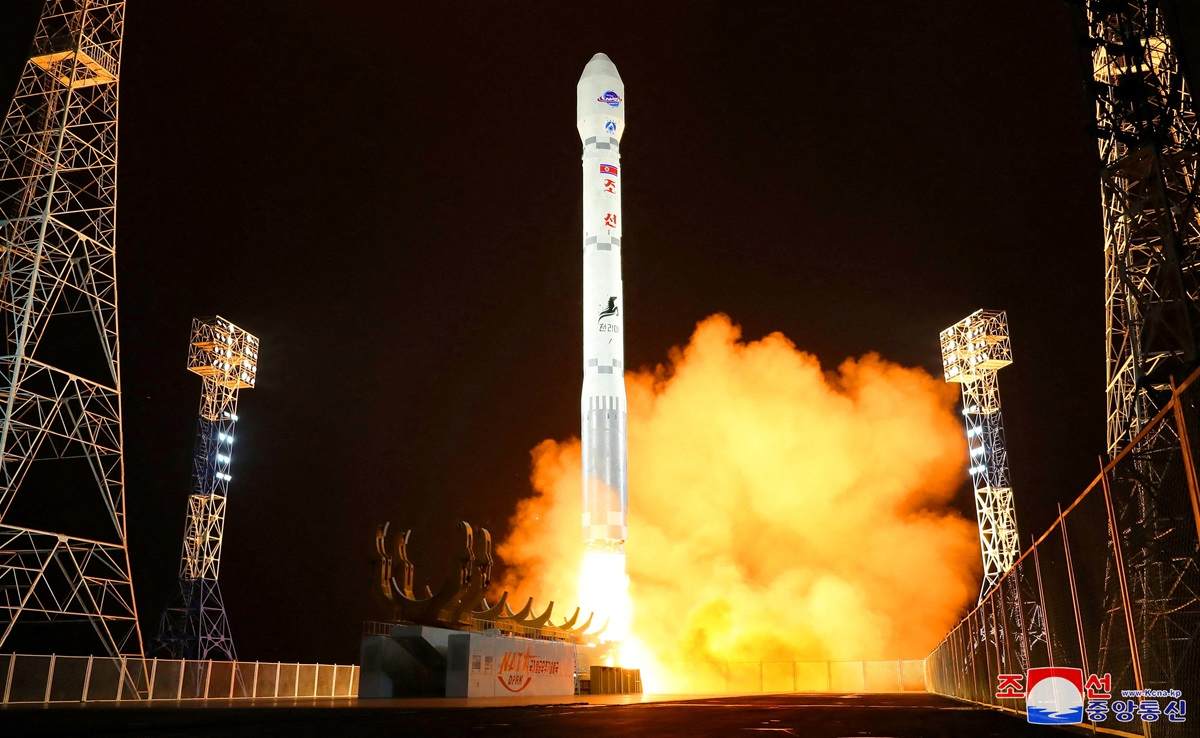N. Korea Aims to Monitor U.S., S. Korean Forces Using Spy Satellites; Russia May Have Provided Technical Assistance

A rocket claimed by the North Korean government to be carrying the Malligyong-1 spy satellite is launched in a location given as North Gyeongsang Province, North Korea, in this handout picture obtained by Reuters on Tuesday.
16:28 JST, November 23, 2023
SEOUL — On Wednesday, North Korea claimed it successfully put a military reconnaissance satellite into orbit the previous night. The apparent success of the launch has raised questions of Russia’s involvement, especially after two previous launches this year ended in failure.
The believed aim of the satellite is to monitor the movements of U.S. and other forces from space and improve its capability to strike with nuclear missiles. Pyongyang also said it would launch several more satellites at an early date. It would pose a threat to Japan, the United States and South Korea if Pyongyang begins full-scale satellite operations.
Image of U.S. Air Force base
According to the official Korean Central News Agency, North Korean leader Kim Jong Un, who is also general secretary of the Workers’ Party of Korea, visited a control center in Pyongyang on Wednesday morning. There he examined an image of Andersen Air Force Base on Guam, which is said to have been sent from the military reconnaissance satellite Malligyong-1. The U.S. Air Force base would serve as a staging area for bombers in the case of an emergency on the Korean Peninsula.
“We now have all the ‘eyes’ to look down on malli [extremely remote areas], and all the powerful ‘fists’ to strike the areas,” Kim said. The “eyes” refer to reconnaissance satellites and the “fists” to missiles. The news agency reported that the Malligyong-1 will begin reconnaissance operations on Dec. 1.
It is not clear whether they actually received any images from the satellite. In March last year, Kim said that the purpose of developing reconnaissance satellites was to spy on the military activities of South Korea, Japan and “U.S. forces and their followers” in the Pacific. He apparently sought to counter Washington by first emphasizing his capture of the image of the air base the day following the launch.
Doubts
The North Korean military has already deployed small drones, but they are not enough to cover even South Korea. Although it is rapidly improving the performance of its diverse missile arsenal, it can hardly determine how and where U.S. forces are concentrating their units.
This is why Kim is persistent about missile development. The five-year national defense plan announced in 2021, for instance, includes the practical use of military reconnaissance satellites.
On Wednesday, Kim reportedly said there is a need to “launch many more reconnaissance satellites and put them into orbit.” He is said to have also decided to discuss next year’s launch plan at a key party meeting scheduled for the end of the year. Possibilities are high that a series of launches will be made as early as next year.
Malligyong-1 is said to have low image resolution. After North Korea failed to launch a satellite in May, the South Korean military recovered and analyzed a portion of the satellite from the sea before concluding that it does not have military utility at all.
Yang Uk, a research fellow at the Asan Institute for Policy Studies in South Korea, said, “At least 40 reconnaissance satellites are said to be necessary to constantly monitor a certain area. Even if North Korea succeeds in launching several satellites, it will not be of great significance immediately.”
Russian Assistance
Pyongyang seems to have been able to fix rocket defects with the technical assistance of Russia. It was only August when North Korea failed to launch a rocket that it claimed carried a military reconnaissance satellite. According to South Korean government officials and others, Russian satellite-related engineers may have flown to Pyongyang from Moscow in late September to fulfill an agreement reached during the summit meeting between Russian President Vladimir Putin and Kim held earlier that month at a space center in Russia’s Far East.
South Korean military officials said that Russian engineers may have provided engine-related technical assistance to North Korea in return for Pyongyang’s provision of ammunition and other items for use in Moscow’s aggression against Ukraine.
Chang Young-keun, the head of the missile center at the Korea Research Institute for National Strategy in South Korea, said that Russian engineers may have held some discussions with their counterparts in North Korea based on data regarding the results of two failed launches. Since Russia possesses highly advanced satellite-related technologies, there are concerns that North Korea’s reconnaissance capabilities could be enhanced if it receives assistance from Moscow.
"Politics" POPULAR ARTICLE
-

Japan to Support Central Asian Logistics Route That Bypasses Russia, Plan to Be Part of Upcoming Summit in Tokyo
-

Japan to Tighten Screening of Foreigners’ Residential Status by Providing Information of Nonpayment of Taxes
-

Chinese, Russian Bombers Flew Unusual Path by Heading Toward Tokyo; Move Likely Meant to Intimidate Japan
-

Japan Plans National Database to Track Foreign Ownership of Real Estate, Land as It Weighs New Rules
-

Up to 199,000 Deaths Estimated From Mega-Tsunami; Most Recent Occurrence Took Place in 17th Century
JN ACCESS RANKING
-

Tokyo Economic Security Forum to Hold Inaugural Meeting Amid Tense Global Environment
-

Keidanren Chairman Yoshinobu Tsutsui Visits Kashiwazaki-Kariwa Nuclear Power Plant; Inspects New Emergency Safety System
-

Imports of Rare Earths from China Facing Delays, May Be Caused by Deterioration of Japan-China Relations
-

University of Tokyo Professor Discusses Japanese Economic Security in Interview Ahead of Forum
-

Japan Pulls out of Vietnam Nuclear Project, Complicating Hanoi’s Power Plans























